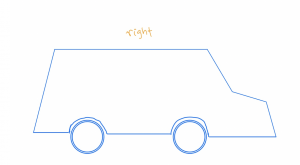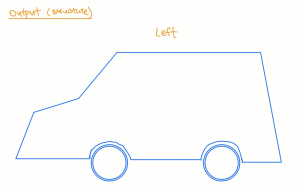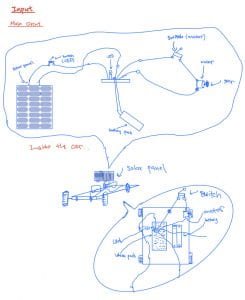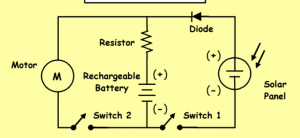A video clip showing my car running for short distances:
IMG_4053
This product, a solar-powered vehicle, would work with the process of converting solar energy into electric energy, then converting it into kinetic energy. The first part of the transfer could be seen in the design when the solar panel powers up the LED light by turning on and off the switch, indicating the electricity that the solar cells produced has been successfully transferred into the LED. Some wasted energy of the part includes light energy (LED lighting up) and thermal energy (high temperature in LED). For the second part of the energy transfer, the electricity produced by the solar cells on the solar panel makes the motor rotate, meaning the electric energy has been converted to kinetic energy. Some other wasted energy in this part of the circuit includes sound energy (the sound produced by the spinning motor) and thermal energy (the temperature of the motor suddenly rise).
Something I did well on this project is that I learned a lot about some background knowledge about the function of a solar panel circuit or system, implemented these skills into my project, and made my vehicle rotate in the still air. Also, I also applied some of the technical terms in mechanical engineering and automotive design such as front-wheel drive and gear drive, which allows me to understand the physics behind energy transferring products such as solar-powered transportation. By applying this background knowledge, I figured out a way to design a useful tool.
Something that I did not do well this time is that I did not use soldering, which would make my circuit much easier, and lighter to drive the car. Thus, my circuit has been extremely messed up, and the car would be stuck most of the time because, frankly, I did not place the wire in a proper manner. Concurrently, I realized that the motor sometimes functions, but not all of them could function well at any moment. To be honest, I had a hard time selecting gears and placing them at the correct spot, and sometimes they slip away from its original position easily, thus resulting in the ceasing of the vehicle’s motion, and it still could not work even if I cut off the other half of the vehicle’s body. Apart from functioning errors, I also felt like my car looks boring, just as simple as a broken part of a real-life vehicle. In other words, it is not aesthetically attractive to my audiences, and they might not be interested in it.
Something that I will do next time to improve the poor quality that I have this time would be the following. Firstly, I would need to make my plan carefully, because I altered my plan at least 3 times during the exploring stage of the project, and I also changed the overall structure and circuit of my vehicle multiple times when I’m making, which would decrease my overall efficiency while working on this. Moreover, I would have to make it aesthetically appealing because it is seemingly that others would question whether my product is a vehicle or not, and making it aesthetically attractive would make more sense rather than altering a car into part of the engine.
This product is indeed planned to be a toy that toddlers could play with. It also reveals how instant would it be for those whose car is running out of fuel in remote and pristine regions. Concurrently, it exposes how useful and protective renewable energy such as solar energy could benefit the environment. Kinetic energy converted from solar energy would cause less noise damage to the environment, and physically benefit the environment by avoiding greenhouse gas emissions.














Recent Comments